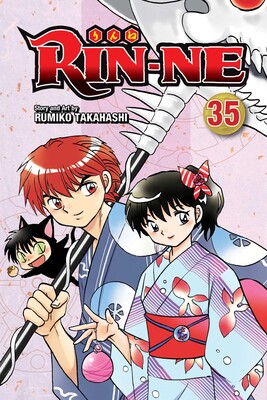Manga Review: Rin-ne #35 by Rumiko Takahashi
Quick recap: Rinne Rokudo is a part-human shinigami (death spirit) who helps lost spirits find the proper afterlife. Due to unfortunate circumstances, he’s poor and destined to stay that way for the indefinite future. He’s assisted by his black cat familiar Rokumon, and a female classmate named Sakura Mamiya who can see spirits and has common sense but no other powers. The rest of the large supporting case is…less helpful.

This volume starts with Rinne, Sakura, teen exorcist Tsubasa Jumonji, and Ichigo going to an inn that’s having a problem with its sunflower field. So, it turns out I never saw or reviewed the volume where Ichigo is introduced so SPOILER! She’s the reincarnation of Rinne’s mother Otome, who passed a few years back. Due to shenanigans, she got her past life memories back, so is a first-grader with the mind of a grown woman.
Which isn’t to say she doesn’t enjoy the life of a small child in many ways. While the group is investigating the sunflower maze, Ichigo runs into Shoma, a wealthy young trainee shinigami, and trades advice for small change. The “sunflower fairy” turns out to be relatively benevolent, just wanting to entertain children, and all ends well.
The final story is set at Halloween, as lazy witch and schoolteacher Annette tries to summon elementals to take selfies with to pass the witches’ council skills test. She promises Rinne payment for his help, but her summoning skills aren’t as precise as one would hope.
In between, the most interesting stories are one about a ghost that forces boys to lie because of his own blackened reputation, and our heroes’ attempts to unravel what really happened centuries ago; and one about a “sin tree.” It’s a plant that has absorbed evil from surrounding spirits until it almost dies. Freelance shinigami like Rinne can earn spare cash by purifying the remaining evil from the plant. Provided no one gives it water.
Except that Sakura innocently sees this dying potted plant and gives it water. The spirit involved was a pimp, and this gives the plant the power to send out solid images of Sakura to do nice things for boys. But it’s “compensated dating” so money vanishes from the boys’ pockets and appears on the tree. Rinne is torn between the fact that this is ill-gotten gains, and that it’s a literal money tree.
Other stories involve hot springs, sea urchins, and love charms for the especially shy.
As always, the humor and art are nice, but there’s no advancement in the overall plot or introduction of new characters, so it’s a non-essential volume. Pick it up if you’re a fan!

